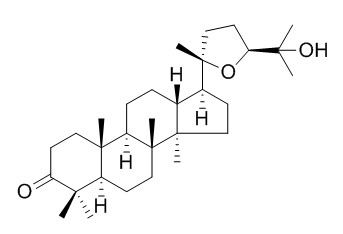Cabraleone
The mixture of cabraleone and ocotillone shows cytotoxicity against HL-60 leukaemia cell line.
Inquire / Order:
manager@chemfaces.com
Technical Inquiries:
service@chemfaces.com
Tel:
+86-27-84237783
Fax:
+86-27-84254680
Address:
1 Building, No. 83, CheCheng Rd., Wuhan Economic and Technological Development Zone, Wuhan, Hubei 430056, PRC
Providing storage is as stated on the product vial and the vial is kept tightly sealed, the product can be stored for up to
24 months(2-8C).
Wherever possible, you should prepare and use solutions on the same day. However, if you need to make up stock solutions in advance, we recommend that you store the solution as aliquots in tightly sealed vials at -20C. Generally, these will be useable for up to two weeks. Before use, and prior to opening the vial we recommend that you allow your product to equilibrate to room temperature for at least 1 hour.
Need more advice on solubility, usage and handling? Please email to: service@chemfaces.com
The packaging of the product may have turned upside down during transportation, resulting in the natural compounds adhering to the neck or cap of the vial. take the vial out of its packaging and gently shake to let the compounds fall to the bottom of the vial. for liquid products, centrifuge at 200-500 RPM to gather the liquid at the bottom of the vial. try to avoid loss or contamination during handling.
Int J Mol Sci.2023, 25(1):283.
International. J. of Food Properties 2017, 20:S131-S140
Front Chem.2023, 11:1245071.
Int J Mol Sci.2019, 20(11):E2734
Sci Rep.2019, 9:12132
Microchemical Journal2023. 191:108938
Antioxidants (Basel).2020, 9(2):E99
Korean Journal of Pharmacognosy2018, 49(3):270-277
Microbiol. Biotechnol. Lett.2022, 50(2): 193-201.
JMSACL2023, 09.002
Related and Featured Products
Nat Prod Commun. 2011 Jul;6(7):983-4.
Cytotoxicity of active ingredients extracted from plants of the Brazilian [Pubmed:
21834238]
Cytotoxicity assays are needed for the screening of natural products with potential anti-inflammatory. The purpose of this study was to compare the basal cytotoxicity of active ingredients extracted from plants of the Brazilian "cerrado".
METHODS AND RESULTS:
The viability was assayed with the neutral red uptake assay in Mac Coy cells after 24h of exposition. The dose evaluated was 50 microg/microL. The test substances were: cinnamic acid, p-coumaric acid, chlorogenic acid, syringic acid, vannilic acid, homogentisic acid, scandenin, palustric acid, diosgenin, Cabraleone. Studies of cytotoxicity demonstrated that all active compounds evaluated have low toxicity in vitro. The substances showed cell viability above 60% for the concentration used. However, the cinnamic acid, sacandenin and palustric acid showed highest toxicity with a 50% reduction in cell viability for the dose of 50 microg/microL.
CONCLUSIONS:
Cytotoxic screening results are useful to estimate the best concentrations of those compounds with potential anti-inflammatory without their cause cell death.
Pertanika Journal of Science & Technology,2014, 22(1):163-74.
Chemical constituents of Aglaia lanuginose.[Reference:
WebLink]
Our continuing research on the Aglaia genus (family Meliaceace) has led us to this first study on the chemical constituents of Aglaia lanuginose (bark).
METHODS AND RESULTS:
The dichloromethane extract from the bark of Aglaia lanuginose showed cytotoxicity against HL-60 leukaemia cell line (45% inhibition) at 20 μg/ml and was prioritised for further investigation. Repeated chromatography of the dichloromethane extract yielded the known dammarane triterpenes which were identified as cabralealactone (1), methyl eichlerianate (2), Cabraleone (3), ocotillone (4), eichleriatone (5), eichlerianic acid (6) and shoreic acid (7) together with the known sterols, sitosterol (9) and stigmasterol (10). Another isolated compound was the aromatic 4-hydroxycinnamyl-acetate (8), which has not been reported to be present in a plant from the Meliaceae family.
CONCLUSIONS:
The structures of all the compounds were elucidated on the basis of spectroscopic methods (IR, MS and NMR). Cytotoxicity testing of 1-10 showed activity only for mixtures of (3, 4), and (5, 6).



